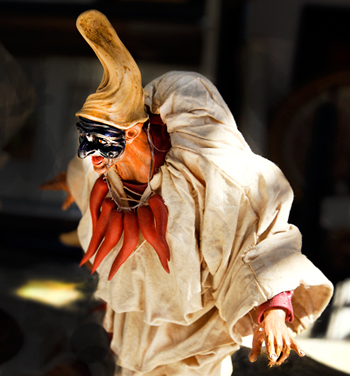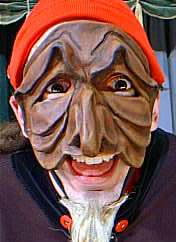- The characters of the masks are made of their physical limitations, posture, gestures and so on. It is only the outer of the masks that make up their character. There is no psychology possible, since it does not go through the mask. In that respect mask theatre is foremost a visual art form.
That doesn’t mean that we in the audience don’t feel with the masks. Our understanding of the masks is instinctive and collective. We see the postures and gestures of the masks and we immediately understand their characters, desires and emotions just by intuition. And since the faces of the characters don’t interfere with the action, we understand directly what is happening. (See HERE) And therefore react emotionally without first intellectualizing.
For example: when I teach the different Commedia dell’Arte masks I just have to ask the actor to find the body posture for a specific mask, without telling him what mask it is. Then I ask him what the nature of the mask he is portraying is. He usually explains it very exact. Usually I divide a class I half, where half the class I watching. And when I then ask the audience, they to explain the character of the mask, quite exactly.
- The mask is always one-dimensional. There is no room for inner conflicting desires (unless that is the main function) within the mask. The character of the mask would dissolve if it would take on more traits. As said HERE, the masks are always types and not genuine human beings. Therefore it is no reason to try to understand how a mask was raised or why the masks the way they are. That doesn’t make them less human though.
It is said that the clown contains a whole world, while the masks only represents one aspect of the world. It is the masks together that make up a complete world. Instead of inner conflicts it is the frictions are between the diverse masks or between masks and characters in a play that drives it forward.
- The mask is static. The masks/characters are the same as their masks. They cannot develop or learn. In the moment they change they die. Just as the face masks are fixed their characters must be fixed. The masks itself have their physical character traits and the character of the masks will always relate to the static fact that that is what they are. (Very complicated sentence.) The moment Pantalone understands that he is wrong and starts to share his wealth, Batman getting old and wonky or when Santa Claus starts taking back his gifts they are no longer their characters.
This is also why they cannot be used in modern plays where the main characters usually go through changes. And as they learn they are not the same as they were when they started, but the mask still stays the same.
The masks are also static when it comes to external matters as occupation, wealth, age, super powers and so on. They are types derived from animals.
See also:
The face – a tool to lie with
About teaching mask
About Micke



One Response to 3 reasons mask doesn’t use psychology